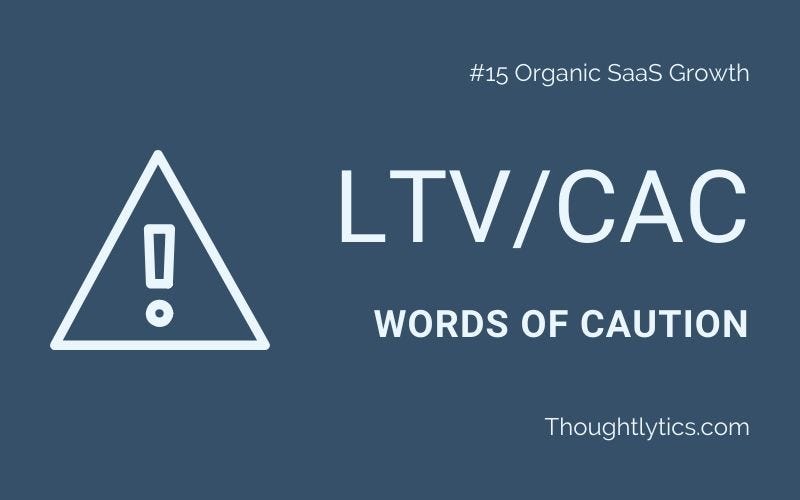Click here to read this post on the website.
Information without context can be lethal.
Ironically, it is all around you.
Knowledge derived from such information fails when put to action.
If you are not attentive, you can incur irreversible losses.
 |
Consider, for example, the curious case of the customer lifetime value (LTV).
If you have ever designed a growth model, you must have come across LTV.
Customer lifetime value is the sum of gross margins from all payments you expect to receive from a paid user.
One of the ways SaaS world talks about LTV is with customer acquisition cost (CAC).
CAC is the total money you spend to acquire a paying customer.
LTV and CAC, together form the basis of a viable growth model:
Acquire new customers by spending as less as possible [low CAC], and
Engage and retain users for as long as possible [high LTV]
Thus low CAC — high LTV is a winning combination.
So far, so good.
But things are going to get tricky very soon.
You will find blog posts from reputed publishers, like this one from Hubspot, suggesting LTV/CAC as a critical metric for SaaS businesses.
Specifically, the post says that you can maintain an LTV/CAC ratio greater than three, and if it is too high, you should increase your sales & marketing spend.
In other words, the post suggests that you can spend up to one-third of LTV to acquire a new customer.
However, it is not entirely correct.
The context is missing here.
The suggestion of LTV/CAC to be three or higher is not valid for early-stage SaaS businesses.
An early-stage business using LTV/CAC as a metric is vulnerable to financial risks.
I am going to explain this with an example.
Consider a SaaS startup X that sells its most popular plan for $299 a month.
The company expects each of its customers to stay with it for three years.
A simple calculation will give LTV as $10764 ($299 x 12 x 3)
Even though it is a rough estimate of LTV, it will be sufficient for today's analysis. A more accurate method to calculate LTV is available here.
At LTV/CAC = 3, CAC will be $3588 (10764/3)
This means the company X can spend up to $3588 to acquire a new customer for a $299 monthly plan.
Assuming a uniform CAC for the sake of calculation, to acquire 500 customers, the upfront cost will be $1.79 million (500x3588).
There are three critical inferences here:
To fuel this kind of growth (customer acquisition), the company will have to raise investment early on or have the risk of running out of money. The business is going to run in the cash flow deficit for many years to come.
It will take more than a year only to recover CAC. Being at early-stage, company X neither has accurate data nor the product-market fit to recover CAC comfortably. A product that does not delight users will have difficulty retaining them. You can not scale high with a thing that pisses its users off.
It will be long before the company builds enough financial resources to self-sustain its growth. Right from the beginning, the financial burden will limit the team's maneuvering capabilities.
None of these are conducive to the growth of an early-stage SaaS business.
What an early-stage SaaS business should rather do?
A better approach would be to:
Not focus on LTV at all. It’s a long shot.
Begin with a small CAC, say equal to the three months of ARPU (average revenue per user) or less. For the $299 plan, design acquisition channels to cost less than $897. A short period will let you recover CAC fast and have sustainable unit economies.
❤️ Thanks for reading Issue #15. I'd truly appreciate it if you hit that heart button & share this with other SaaS people you know that will find it useful.
We'll talk soon.
Until then,
Ankur
Founder, Thoughtlytics
PS - Are these emails provoking questions or reactions? Hit Reply and let me know what's on your mind. Don't be shy! ❤️
If you liked this, please forward it to a friend! It would mean a lot to me. Or send them to the Organic SaaS Growth newsletter.
Were you forwarded this email? You can subscribe to the newsletter or explore the past editions.
For tweets: @Thoughtlytics
SaaS growth models - Instagram

